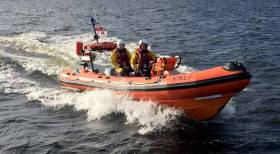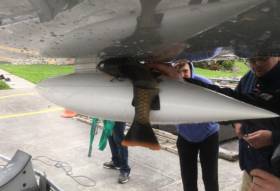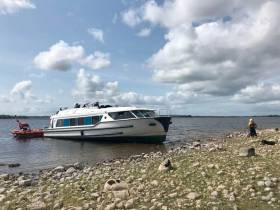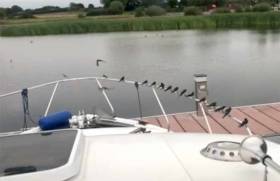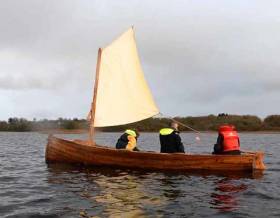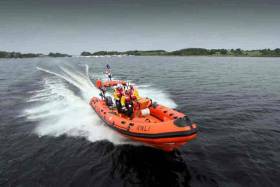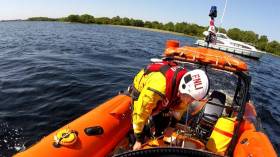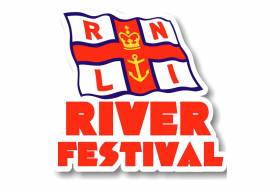Displaying items by tag: Lough Ree
The Portadown Pikers Angling Club laid wreaths at the Coosan Point Memorial last Saturday 23 March in memory of their fellow anglers David Warnock and Daryl Burke, who drowned in Lough Ree in a tragic incident five years ago.
The two men, and colleague John Trimble, were thrown into the water after their boat overturned near Hodson Bay on the afternoon of 20 March 2014.
In 2015 the Marine Casualty Investigation Board concluded that hidden flooding destabilised the anglers’ boat causing them to go overboard.
This past weekend the angling club party — which included Trimble, who survived the incident — were joined by a group from Lough Ree RNLI for the wreath-laying ceremony and some refreshments at the lifeboat station.
Pikers chairman Noel Quinn later made a generous donation to the Lough Ree lifeboat before the group departed to Lanesborough where they spent the weekend fishing.
Brian and Hayley Warnock also laid wreaths in memory of their son David.
#Lifeboats - RNLI volunteers at Lough Ree have launched their sixth Lap of Lough Ree charity cycle which will take place this year on Sunday 28 April.
The annual 85km cycle raising funds for the lifesaving service in Athlone will go anti-clockwise around Lough Ree starting and finishing at The Bounty at Buccaneers Rugby Club, with a pit-stop in Lanesborough at the north of Lough Ree.
Speaking at the launch, Sarah Bradbury, Lough Ree RNLI volunteer lifeboat press officer, said: “We are delighted with the support that the cycle has received each year and that it’s becoming a favourite in the cycling calendar.
“This is a relatively relaxed route for cyclists to ease themselves back into the saddle while taking in the stunning views of Lough Ree.
“Those who participate in the cycle do so knowing they are raising vital funds for Lough Ree RNLI and we would like to thank them in advance for that.
“Funds raised will maintain and equip our inshore lifeboat and will allow our volunteer crew to continue to train and develop their lifesaving skills so when the need arises they can help those who get into difficulty on the lake.”
Registration for the event (entry fee €20) will start at 9am on 28 April in The Bounty. Further information on the cycle and updates can be found on Facebook.com/loughreernli or by emailing [email protected]
Lough Ree RNLI & Athlone Sub Aqua Club Respond to Late Night Report of Person in the Water
Lough Ree RNLI and Athlone Sub Aqua Club volunteers responded to reports of a person in the water in Athlone town late last night.
At 11.25pm on the 30 December 2018 Lough Ree RNLI volunteers were alerted by the Irish Coast Guard in Malin Head to reports of a person in the water at Athlone Town on the Quays between the Castle and Sean’s Bar. Athlone Sub Aqua Club was also alerted to the incident.
The volunteer crew on board the inshore lifeboat, The Eric Rowse were quickly on scene and immediately commenced a search for the person. They were joined by members of Athlone Sub Aqua Club. Conditions at the time were very calm with partial visibility due to darkness.
A casualty was taken from the water and handed into the care of HSE Paramedics who were waiting on the quayside and brought to hospital.
Athlone Gardai have sadly confirmed that the person subsequently passed away.
Lough Ree RNLI and Athlone Sub Aqua Club would like to extend their sincere condolences to the family at this time.
Something Fishy On Wag Pair’s Keel At Lough Ree This Past Weekend
Peter Kennedy made waves on Lough Ree when the current SB20 national champion took the Helmsman’s Cup at the weekend.
However, a special mention must go to Water Wag pair Guy Kilroy and Adam Winkelmann for their ‘catch of the day’ as they discovered an unusual and large fishing lure caught on their keel.
The extra weight and drag, however small, surely didn’t help their campaign at the All Ireland Sailing Championships — but perhaps it also means a good omen for next year’s event?
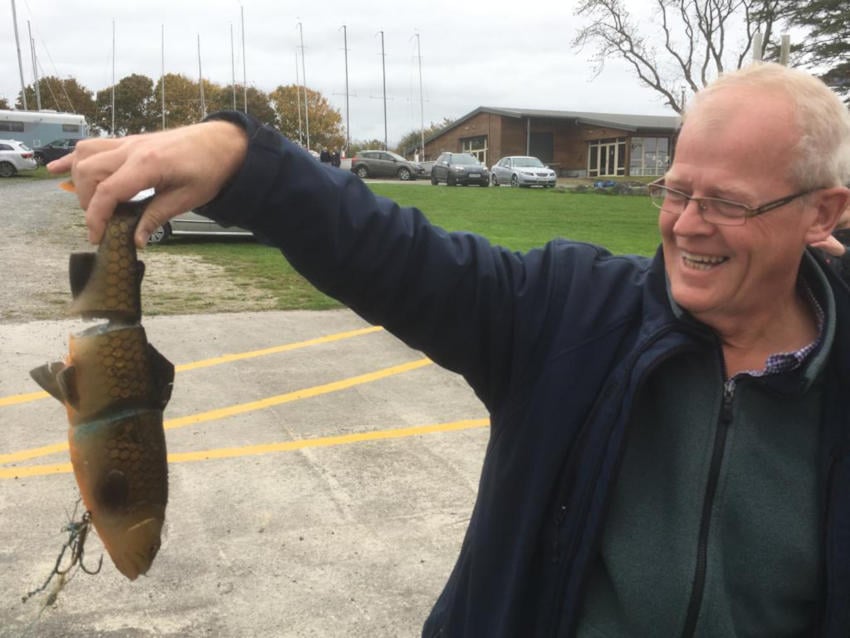
Lough Ree Lifeboat Rescues Four From Boat Hard Aground
#RNLI - Lough Ree RNLI volunteers have rescued four people whose 37-foot boat had run hard aground on the Longford shore.
At 12.17pm yesterday afternoon (Wednesday 29 August) the Irish Coast Guard in Malin Head tasked the Lough Ree inshore lifeboat to the north of Priest Island, at the north of Lough Ree.
Once on scene, the crew members found a boat in deep water at the stern while the bow was out of the water.
Having checked that all onboard were uninjured and that the boat was undamaged, the lifeboat crew attempted to tow the boat into deeper water. Unfortunately they were unable to do so.
Lifeboat helm Stan Bradbury spoke directly to the boat hire company involved, who were sending further assistance.
Speaking after the callout, Bradbury said: “It’s important to remain aware of your surrounds when out on the lake and how close to the shore you may be.
“We would also like to extend our thanks to the lady who contacted the coastguard and remained on scene until our volunteers arrived.”
Elsewhere, Baltimore RNLI was called out to a fishing vessel in difficulty south of Kedge Island.
The eight-metre fishing boat, with two people onboard, had become propped on discarded netting three miles off the island near Baltimore in West Cork.
The lifeboat established a tow and brought the vessel back to Baltimore Harbour, arriving just over an hour after the call came in.
“Today’s call highlights one of the hazards of materials being discarded at sea,” said Baltimore RNLI press officer Kate Callanan.
Shannon Ornithologists, Please Swallow This…
Portrunny on the northwest shore of Lough Ree is a secluded and very peaceful place renowned for its bird life.
But even so, the crew of the good ship Scruples II berthed there recently reckoned they might have reached a record with at least 28 swallows settling on the forward rail, with others hovering about.
We have to admit that even the fully assembled Afloat.ie Nature Watch team haven’t a clue about adjudicating on this – can any of our increasing number of visitors help?
Nollaig Molloy, a conceptual artist from County Roscommon, has been researching aspects of life in times past on the islands and shores of Lough Ree on the River Shannon in her Sounding the Shore project, which will conclude with a public Film Screening and Audio Event on Saturday August 25th in the hidden remains of an Anglo-Norman lakeside fortress/town.
Her work has included a study of the use by island and shore-dwelling lake people of small but effective sprit-sails for their working lakeboats, traditional rowing craft which in due course evolved into efficient sailing boats which ultimately inspired the creation of the Shannon One Design in 1922.
 The Lough Ree lakeboat with sprit-sail in Barley Harbour on the Longford shore
The Lough Ree lakeboat with sprit-sail in Barley Harbour on the Longford shore
The final night’s programme is complex, and is best explained in her own words:
“Dear friends and colleagues,
I would like to invite you to tune into the final broadcast and attend the final public event of Sounding the Shore on the 25th of August.
Broadcast:
Tune into Athlone Community Radio 88.4FM or at https://athlonecommunityradio.ie/listen-live/ from 1.30pm-3.30pm as we broadcast from the clinker built lake boat with sprit sail from Rindoon, St Johns, Lecarrow, Co. Roscommon
In this episode we will broadcast from Rindoon, in the remains of an Anglo Norman town situated on the west shoreline of Lough Ree. We will hear about the conservation efforts of the 13th century walled town, Rindoon located on a peninsula on Lough Ree, the islands close to it, island life, boatbuilding, eel fishing and much more.
Film Screening and Audio event: Open to public
Date: August 25th
Time: 9pm-11pm (with screening happening 9.20pm)
Venue: Safe Harbour, Rindoon, St John's, Lecarrow, Co. Roscommon
On the night of the 25th of August at 9pm and as part of Heritage Week 2018, we will be holding the final public event of Sounding the Shore at Safe Harbour, Rindoon, St Johns, Lecarrow, Co. Roscommon.
Films showing:
Sounding the Shore, 2018 by Nollaig Molloy featuring Ballyleague Men's Shed: a premiere screening of a documentary style film showing the process of the project Sounding the Shore.
Shannon One Design, 1988, HANDS by David and Sally Shaw Smith
Where the Shannon Flows Down to the Sea, 1939 by Richard Hayward
It is an outdoor film screening and audio event, so it is advised to wear adequate waterproof footwear and clothing, and to bring a torch. In order to experience the event in full, you must bring a device which connects to FM radio i.e. a battery powered radio or a smart phone with radio app. etc.
This is free admission. Please note the ground is uneven and it will take at least a 30 minutes walk to get to Safe Harbour from the green gate at Rindoon entrance. Stewards will usher groups from gate entrance to event site.
Please contact me for more details.
This event is made possible by supports from CREATE: Artist in the Community Scheme of the Arts Council of Ireland, Roscommon Arts Office, Roscommon Heritage Office and The Irish Walled Towns Network, Heritage Council of Ireland.
Kind Regards,
Nollaig Molloy
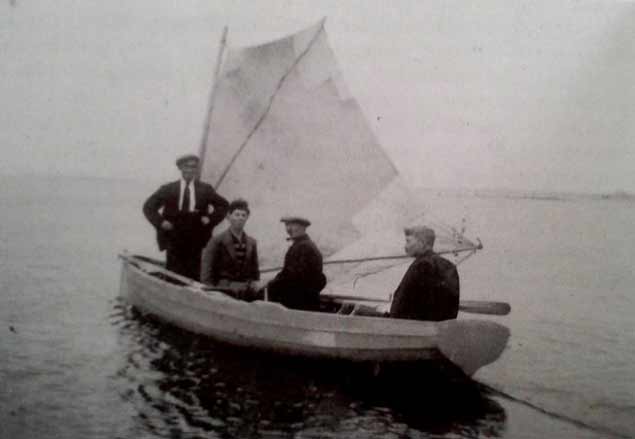 An early photo of a Lough Ree lakeboat with a primitive spritsail
An early photo of a Lough Ree lakeboat with a primitive spritsail
 The Shannon One Designs of 1922 are said to have their origins in sailing versions of the traditional lakeboats
The Shannon One Designs of 1922 are said to have their origins in sailing versions of the traditional lakeboats
Lough Ree RNLI Warns of Low Water Levels
After four call-outs in three days to help fifteen people, reported earlier by Afloat.ie here, Lough Ree RNLI station has issued a warning to boat users that water levels may be lower than usual and to take more care writes Tom MacSweeney.
Sarah Bradbury, the Station’s Press Officer said that while it was great to see so many people enjoying Lough Ree and all that it has to offer, there was a need to respect the water and to keep to the main navigation channels where the water is deeper.
On Sunday, Monday and Tuesday, the lifeboat crew assisted boats which got into difficulty in incidents which included grounding and losing power.
Lough Ree RNLI Station was set up six years ago, in 2012 and operates an inshore rigid inflatable lifeboat. With a high level of call-outs, it is due to get a bigger boat and a new station building.
I was there in the past few weeks to meet Sarah Bradbury and the Lifeboat Operations Manager, Tony McCarth, who outlined to me, with what has proved to be great foresight, the particular problems of lake and lough boating.
Listen into the Podcast below
Lough Ree RNLI Rescue Tourists From Boat on Rocks
At 11am yesterday morning, (6 June 2018), Lough Ree RNLI inshore lifeboat crew were requested to launch by the Irish Coast Guard in Malin Head to go to the assistance of 4 people whose boat had got stuck on Slate Rock near Yew Point, north of Hudson Bay on the Roscommon shore of Lough Ree. Conditions were very calm with a very gentle south easterly breeze.
The inshore lifeboat, the Eric Rowse with helm Stan Bradbury, and crew members Liam Sherringham and Kieran Scullion on board were quickly on the scene and checked that everyone on the boat was OK and the boat was not taking on water before getting ready to try to tow the boat off the rocks. After several unsuccessful attempts to remove the boat from the rocks, it was decided to bring the 4 people on board to Hudson Bay before returning to the Lifeboat Station.
"After several unsuccessful attempts to remove the boat from the rocks, it was decided to bring the four people on board to Hudson Bay"
Speaking after the callout, Lifeboat Operations Manager, Tony McCarthy said, ‘As the lovely weather continues we would like to remind anyone heading out on the lake to wear a lifejacket. If you are not sure if your lifejacket is suitable for use, please contact us and we can arrange for a member of our Community Lifesaving Team to assess it for you”.
Athlone River Festival Promises A Fun-Filled Weekend
#Festivals - The River Shannon will come alive with the Athlone River Festival later this month.
The Shannon has long been the base for festivals in the midlands centre, from the original Athlone People’s Regatta in the 1920s to the Athlone River Festival in the 1990s that was revived in recent years.
And this year, over the weekend of 30 June and 1 July, festival fever will be hitting Athlone once again thanks to Waterways Ireland and with the support of Westmeath County Council and Lough Ree RNLI lifeboat volunteers.
“Lough Ree RNLI has received huge support from the communities around Lough Ree and we would like to repay the community with a fun-filled water-based weekend for all to enjoy,” said lifeboat volunteer Damien Delaney.
Saturday 30 June will see the IWAI motor cruiser flotilla sail-past and arrival into the town, prior to the start of the TriAthlone.
On Sunday 1 July, activities start at 10.00 am with the very popular junior fishing competition organised by Athlone anglers, followed by a variety of activities including a sailing demonstration, rowing races, sub-aqua demonstration, flyboarding and the main event, the RNLI raft races — which this year come with a new junior category.
A full timetable and further information, including entry details for the raft race and contacts for interested sponsors, can be found on the Athlone RNLI River Festival Facebook page.




























